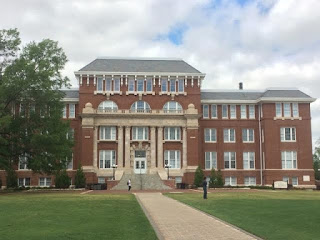The Cotton District in Starkville, Mississippi is one of the very first examples of New Urbanism. Designed by Dan Camp, it is known as one of the first communities designed in the ideals of New Urbanism, and considered a predecessor to the movement. A key feature is the fact that it is designed to appeal to the old American aesthetic of quaint neighborhoods which are tight-knit and close together. The area is designed so that almost anything is within walking distance, and as such it is important that all buildings are designed with this in mind.
Thursday, April 27, 2017
Wednesday, April 26, 2017
Disney Castle, very similar in many ways to Hyrule Castle from the previous blog post, is in the Gothic architecture style. The pointed arches are a large feature of the style, as well as the towers with spires on them. The Disney Castle is heavily ornamented, which is characteristic of Gothic architecture.
While it exists within a video game, Hyrule Castle of the Legend of Zelda series exhibits prominent qualities of Gothic architecture. One of the most noticeable features that points to this style is the flying buttresses located around the central castle. It also has plenty of towers with pointed spires, which are a characteristic of Gothic architecture as well. There is also heavy use of ornamentation closer up. There are a few deviations, however, primarily being that the arches are curved, not pointed.
Tuesday, April 25, 2017
Lee Hall (top image) and Swalm (bottom image) are both examples of Neoclassicism. Neoclassicism is influenced by city building, and these buildings mimic that in the way that their positioning is affected by the rest of the college surrounding it. Both buildings bookend the Drill Field, making them seem as though they are the most important buildings in the area. Their ornamentation is a bit simple for neoclassicism, but their use of pillars and stairs is very imitative of the style. Another unique distinction is the red brick which is uncommon as most neoclassical buildings tend to have a clean, white stone as the main building material.
Saturday, April 22, 2017
Architects in Venice were presented with a fairly unique architectural challenge. While the city is not exclusively accessed by water, as there are many streets, water is the primary means of transportation from building to building. The architects must take many things into account that most others never have to think of, primarily making buildings that have easy to access entrances no matter the tide. The buildings are beautiful, but utility seems to be the main concern, and buildings must be built to avoid water damage during the higher waters that tend to come in the winter. Balconies are very common among the buildings, and they seem to have a Roman influence particularly in the semi circular archways.
When architecture is mentioned, often times we tend to think only of large buildings which humans inhabit. I believe, however, that smaller scale pieces are just as much architecture as anything else, and can even be more interesting sometimes. The image above is an official Lego set of Frank Lloyd Wright's Fallingwater. While the building had already been designed, of course, by forcing themselves to use a different medium and building materials, the designers for the Lego set were architects in their own right as they had to think of new ways to create the same overall design without compromising the original design. While the straight edge features of the original building made this an easier task, it still must find a compromise in many of the features. Almost all Lego architecture is constrained to flat-edged pieces, so designers must figure out ways to utilize that and still create the visual feel of various textures and shapes.
Tuesday, April 18, 2017
While Allen Hall's interior design is very confusing (I find it difficult to locate my advisor every time I go here), I do believe there is actually some merit to the exterior design. The doors are not inviting, and there is not a particular set of doors that seems to be the main doorway. This, however, is actually the genius behind its design! The architect knew that with Allen Hall's purpose, it would be a location where many students would be entering and exiting constantly. By creating many doorways with none of them being more alluring than any other, it splits up the traffic so that none of the doorways are ever too crowded.
(Image courtesy of Wikipedia)
While gingerbread houses are not intended to be used by humans for anything besides consumption, I would argue that they do count as architecture. They still must follow the Vitruvian principles of Venustas, Firmitas, and Utilitas, though the last one is not quite as important. Gingerbread houses exist primarily as a form of beauty. They follow a brutalist style, as the building materials used for structure are very much out in the open, except in some of the larger ginger bread houses which may use hidden toothpicks to hold pieces together. The material used to cement the pieces of gingerbread together is frosting, which is not only visible but often ornate. However, it diverges from brutalism in that candy is used solely for decorative purposes.
Subscribe to:
Comments (Atom)
















